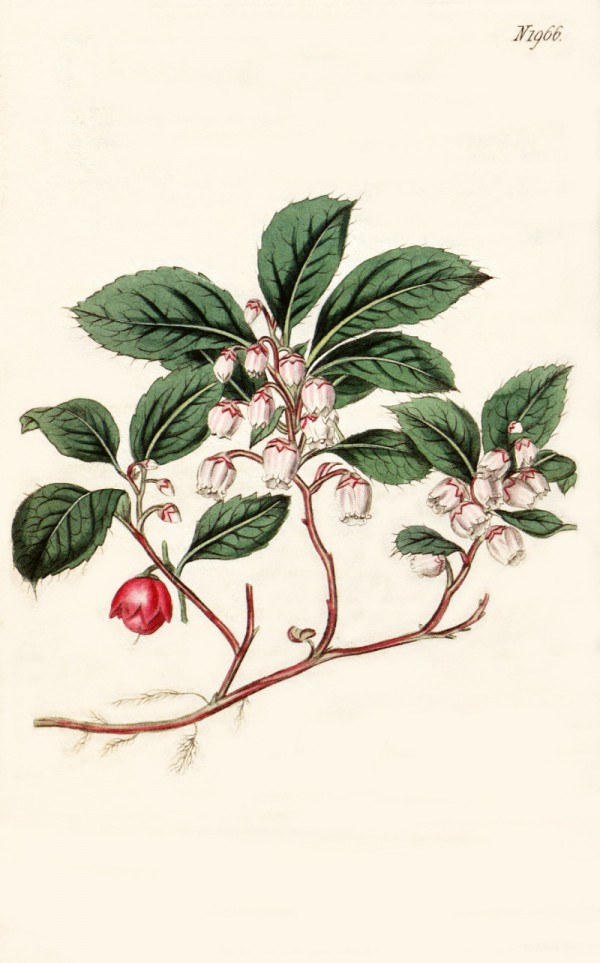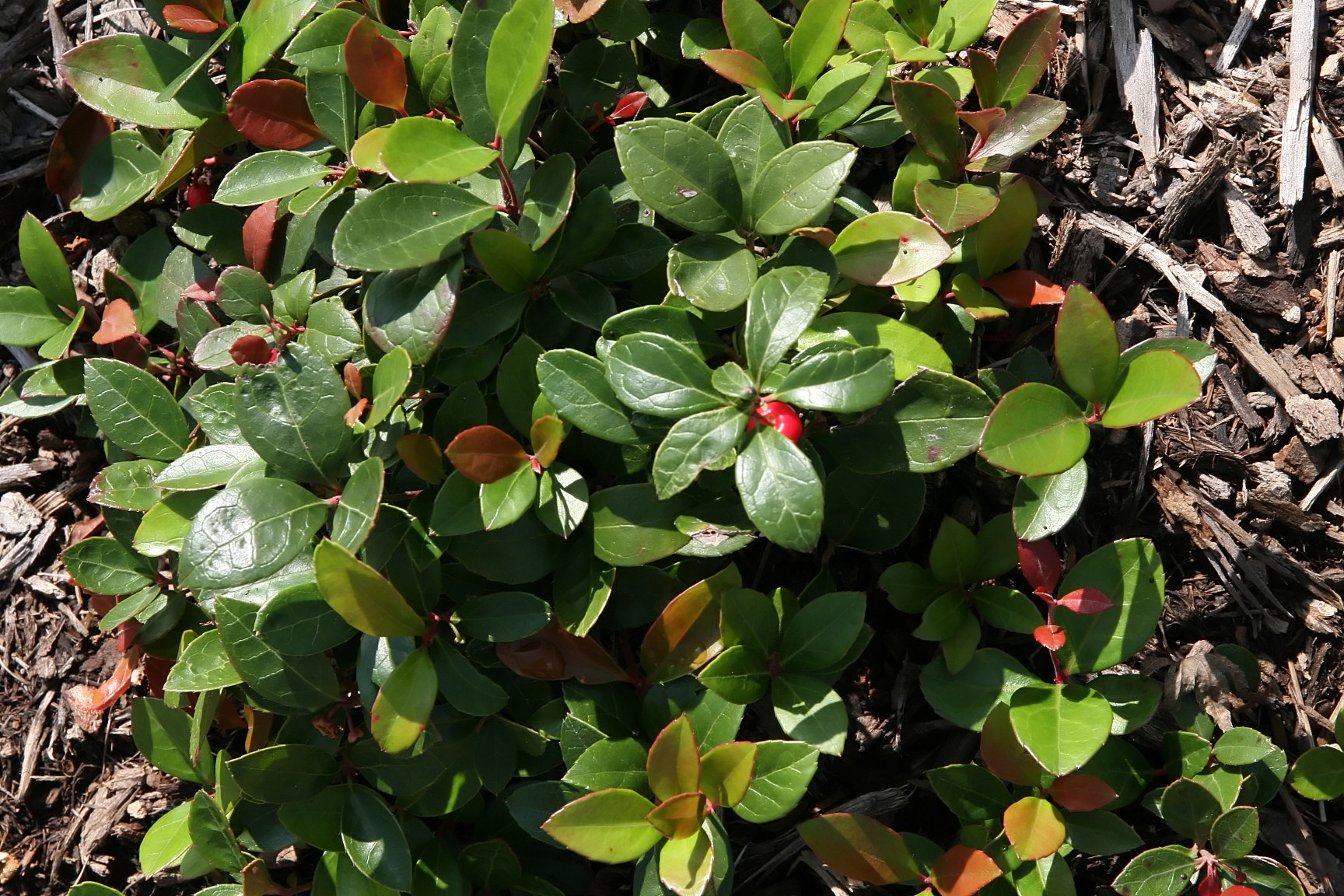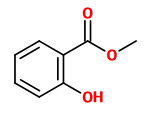Dies ist eine alte Version des Dokuments!
Gaultheria procumbens L. - Ericaceae - checkerberry, creeping wintergreen, Niedere Scheinbeere, Wintergrünstrauch
Creeping subshrub, native to Northern America; leaves obovate to oval or orbiculate, serrate, pale green abaxially, bright green, glaucous adaxially; flowers axillary, solitary, or with 2-3 nodding per node, corolla urceolate, white; fruits bright red to reddish violet, 6-9mm wide.
http://www.efloras.org/florataxon.aspx?flora_id=1&taxon_id=220005469
„The fruits of G. procumbens, considered its actual „teaberries,“ are edible, with a taste similar to Candy Hearts and the leaves and branches make a fine herbal tea, through normal drying and infusion process. For the leaves to yield significant amounts of their essential oil, they need to be fermented for at least 3 days.“
https://en.wikipedia.org/wiki/Gaultheria_procumbens
„Oil of wintergreen (Gaultheria) contains about 99 per cent of methyl salicylate, together with a small amount of a paraffin, which is probably triacontan…, an aldehyde or ketone…, and an ester… wintergreen and birch oil so far resebmle each other, with the exception that the former contains the free alcohol C8H16O … This alcohol posesses so powerful an odor that it imparts the gaultheria oil a character by means of which a person experienced in handling these two oils can in most cases readily distinguish between them.“ [Power, B., Kleber, C., „Oil of wintergreen and oil of sweet birch.“ Pharm. Rundsch, New York, october (1895); also in: Fritzsche Brothers, Circulars of information No.7, 1894]
In G.procumbens, a major part of methyl salicylate is bound to sugars, especially to the disaccharide primeverose (6-O-β-d-xylopyranosyl-d-glucose) to form gaultherin (26mg/g plant fresh weight). Gaultherin is enzymatically hydrolyzed upon tissue disruption and methyl salicylate is released as a protective mechanism for the plant. Total salicylate content of wintergreen tissues were found (mg/g fresh weight): leaves (3.8), flowers (6.4), stems (2.2), and berries (1.4).
[Ribnicky, David, Alexander Poulev, and Ilya Raskin. „Recovery of gaultherin from plants.“ U.S. Patent Application No. 09/887,766. (2002)]
Decoctions of the leaves and the essential oil are used in traditional medicine „… externally as a counterirritant to treat painful muscles and joints, including rheumatism. Infusions, decoctions or small amounts of the oil are rarely taken internally, as tonic, to treat rheumatism and to relieve minor stomach upsets. Canadian Natives traditionally made a refreshing tea from the leaves… methyl salicylate… has a very characteristic smell and a sweetish taste. Nowadays, synthetic methyl salicylate has largely replaced the natural product… [in oinments to treat rheumatism eg.]“
[Medicinal Plants of the World. Ben-Erik Van Wyk and Michael Wink, Pretoria 2004, 153]
„GC-MS analysis showed that methyl salicylate (96.90%) was the main component of the oil. Essential oil inhibited the growth of all microorganisms tested, i.e. food and oral bacteria and fungi, respectively (MIC 0.18-3.00 mg/ml and MBC 1.25-4.00 mg/ml; MIC 0.73-5.00 mg/ml and MFC 2.92-26.67 mg/ml); The oil effectively inhibited the biofilm formation of oral Streptococcus mutans and Candida albicans as well (MIC 25.00 MBC 50.00 mg/ml; MIC 12.50, MFC 50.00 mg/ml).“ Minor components of the essential oil were limonene (2.1%), α-pinene (0.2%), β-pinene (0.2%), fenchone (0.1%) and menthone (0.1%).
[Chemical composition and biological activity of Gaultheria procumbens L. essential oil., Nikolić, M., Marković, T., Mojović, M., Pejin, B., Savić, A., Perić, T., Soković, M., Industrial Crops and Products, 49, 2013, 561-567]
Methyl salicylate is also the main component of the leaf oil of Gaultheria fragrantissima (94.6-97.0%) and Gaultheria yunnanensis (99%). A minor component is eg. ethyl salicylate, especially in G.fragrantissima (5.3%).
[Gaultheria: Phytochemical and pharmacological characteristics., Liu, W.R., Qiao, W. L., Liu, Z.Z., Wang, X.H., Jiang, R., Li, S.Y., She, G.M., Molecules, 18(10), 2013, 12071-12108] http://www.mdpi.com/1420-3049/18/10/12071
Main component of the hydrodistilled (with cohobation, continuous re-injection of the hydrosol into the still) essential oil of freshly mazerated stems and leaves of G.procumbens (collected in the Canadian boreal forest) was methyl salicylate (98.7%). A minor component was ethyl salicylate (0.5%).
„When we collected the essential oil and during a subsequent olfactory evaluation, we did not notice an odor very different from those of commercial batches we use to analyse but surprisingly, when we opened the still lid, we got a strong coconut scent emanating from the distilled plant. This observation stayed outstanding until the analyses when we identified some uncommon compounds in the essential oil and the hydrosol.“
The essential oil contained tuberolactone (0.15%) and massoia lactone (0.08%). The hydrosol contained mainly methyl salicylate (~270mg/l), but also e.g. (E)-cinnamyl alcohol 2.8mg/l, tuberolactone (2.0mg/l) and massoia lactone (0.3mg/l).
https://www.phytochemia.com/en/2018/07/03/about-canadian-wintergreen/

Curtis’s Botanical Magazine, vol.45 t.1966 (1818)
http://plantgenera.org/species.php?id_species=455570

Gaultheria procumbens L. at North Carolina Arboretum, Asheville, NC.; author: David J. Stang
http://creativecommons.org/licenses/by/4.0/ Wikimedia Commons

